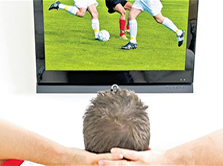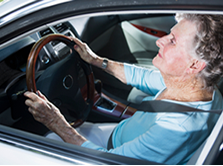The mission of the Mobility Division is to focus on challenges to physical movement across the life span. The goals of the Division are first, to address fundamental issues by supporting research in areas ranging from biology to the design of the built environment and second, to help translate the fruits of that research into products and policies that sustain or enhance mobility or develop accommodations for those individuals with limited mobility.
2013-14 PROJECTS
SEDENTARY BEHAVIOR AND EXERCISE
THE SCIENCE OF SEDENTARY BEHAVIOR
 The Center continues to pursue two follow-up projects to the Blue Shield pilot run in 2013.
The Center continues to pursue two follow-up projects to the Blue Shield pilot run in 2013.
• Dr. Laura Carstensen’s Life Span Development Lab is in discussion with the County of Santa Clara to investigate the effectiveness of various techniques in motivating more standing in the workplace. The study would use the same desks as the Blue Shield pilot. Priority has been given to this project and details are in work with the county at this time.
• Dr. Cathy Heaney is in discussion with Blue Shield about a study in another of their call centers to attempt to replicate the results and also investigate motivational techniques.
FITNESS ACROSS THE LIFE SPAN
 In July 2014, the President’s Council on Fitness, Sports and Nutrition (PCFSN) signed a Memorandum of Understanding (MOU) with the Stanford Center on Longevity (SCL) to work together to “identify strategies to advance awareness and promotion of physical activity, fitness, and nutrition throughout the entire life span, but especially targeted to helping individuals of all abilities at age 50 and above.” The collaboration solidifies the Council’s expanding focus that recognizes the need for people of all ages to remain active, which can help improve quality of life and reduce the instance of chronic disease. The Center will look for innovative ways help the Council reach their goals, beginning with a conference designed to engage a diverse set of experts from academia, industry, non-profit organizations and government entities to identify innovative research and program opportunities that support promotion of physical activity for those over 50. Read more >
In July 2014, the President’s Council on Fitness, Sports and Nutrition (PCFSN) signed a Memorandum of Understanding (MOU) with the Stanford Center on Longevity (SCL) to work together to “identify strategies to advance awareness and promotion of physical activity, fitness, and nutrition throughout the entire life span, but especially targeted to helping individuals of all abilities at age 50 and above.” The collaboration solidifies the Council’s expanding focus that recognizes the need for people of all ages to remain active, which can help improve quality of life and reduce the instance of chronic disease. The Center will look for innovative ways help the Council reach their goals, beginning with a conference designed to engage a diverse set of experts from academia, industry, non-profit organizations and government entities to identify innovative research and program opportunities that support promotion of physical activity for those over 50. Read more >
STANFORD CENTER ON LONGEVITY DESIGN CHALLENGE
 The finals of the Stanford Center on Longevity Design Challenge were held on April 10, 2014 and attended by approximately 200 people. Sponsored by the New Retirement Forum (NRF) and in collaboration with Aging 2.0, the challenge was open to all accredited U.S. and international universities. The challenge for the initial year was “Maximizing Independence for those with Cognitive Impairment.” Secondary sponsorship was secured from multiple companies that allowed the Center to offer a true global challenge.
The finals of the Stanford Center on Longevity Design Challenge were held on April 10, 2014 and attended by approximately 200 people. Sponsored by the New Retirement Forum (NRF) and in collaboration with Aging 2.0, the challenge was open to all accredited U.S. and international universities. The challenge for the initial year was “Maximizing Independence for those with Cognitive Impairment.” Secondary sponsorship was secured from multiple companies that allowed the Center to offer a true global challenge.
We received 52 submissions from 31 universities representing 15 countries. Seven finalists were announced in January and all attended the finals in person, including teams from Singapore and Denmark. Many of the leading aging service providers also attended, many of whom acted as judges. The keynote talk was given by Dr. Justine Cassell, Chair of the World Economic Forum Global Agenda Council on Robotics and Smart Devices. The event also included talks from two leading Stanford researchers; Dr. Frank Longo (Alzheimer’s research update) and Dr. Dolores Gallagher-Thompson (the effect of dementia on caregivers.) An investor panel provided interesting insight into how aging-related companies are viewed by the venture capital world.
The first place prize of $10,000 was awarded to Sha Yao from the Academy of Art University in San Francisco and her design “EatWell,” which was a very carefully researched and executed re-imagining of a tableware set for those with Alzheimer’s. Ms. Yao was inspired by her grandmother, who suffers from the disease. The highlight of the event followed the presentation of the awards. The Vice President of Dementia Care from Brookdale Senior Living, the largest senior living provider in the U.S, announced her desire to buy these dishes for her patients. This was followed by a commitment from Direct Supply, the largest distributor to aging providers, to work with Ms. Sha to productize her design. This effort is already underway.
Second place and $5,000 was awarded to the team from the National University of Singapore for their design “Taste+, a spoon that electrically stimulates the taste buds for those with a diminished sense of taste, which can be related to dementia. Third place and $2,000 went to “Memory Maps” from the Copenhagen Institute of Design. This was a way for patients and families to record memories in a geographically linked way.
Feedback and press from the challenge has been excellent. We have announced a second year of the challenge, this time targeting “Enabling Personal Mobility across the Life Span.”A closing talk was given at the finals by Hannah Torkelson from the President’s Council on Fitness, Sports, and Nutrition, in which she announced the council’s intention to work with SCL on next year’s challenge. We are also in discussions with the World Economic Forum on how they can participate in next year’s challenge. Visit the 2013-2104 Challenge website. >
Stanford News story on the challenge: “Stanford Center on Longevity competition challenges students to design products for seniors”>
STRENGTH AND FRAILTY
The Center is investigating basic muscle biology through the work of The Rando Laboratory. The lab is directed by Dr. Thomas Rando, the Deputy Director of the Center on Longevity. The main areas of research for the Rando Lab are muscle stem cell biology, muscle stem cell aging, muscular dystrophies, tissue engineering, and basic muscle cell biology. Read more about research at the Rando Lab. >
In September of 2013, Dr. Rando and his co-principal investigator, Tony Wyss-Coray, PhD, received one of 10 NIH Transformative Research Awards. These awards, open to both individuals and teams of investigators, were created to support research projects that have the potential to create or overturn fundamental paradigms. Read more about this award and other news about the Rando Lab. >
AGING IN PLACE
AUGMENTING VEHICLES FOR THE OLDER DRIVER
 The Center’s joint launch conference with the Center for Automotive Research at Stanford (CARS) occurred on March 27-28, 2014, sponsored by The Hartford and AARP. The event had representation from the majority of the global auto manufacturers as well as several top-tier suppliers of automotive technologies. Several key researchers from Stanford also attended and represented what is known about people aging physically, cognitively, and emotionally. The group reached a general consensus very quickly that true self-driving vehicles are likely 20 years away, primarily because 100% of driving conditions must be solved with extremely high reliability before wide-spread deployment can be considered. The focus then moved to what could be done given the state of technology now and in the foreseeable future. Some very compelling possibilities emerged, including:
The Center’s joint launch conference with the Center for Automotive Research at Stanford (CARS) occurred on March 27-28, 2014, sponsored by The Hartford and AARP. The event had representation from the majority of the global auto manufacturers as well as several top-tier suppliers of automotive technologies. Several key researchers from Stanford also attended and represented what is known about people aging physically, cognitively, and emotionally. The group reached a general consensus very quickly that true self-driving vehicles are likely 20 years away, primarily because 100% of driving conditions must be solved with extremely high reliability before wide-spread deployment can be considered. The focus then moved to what could be done given the state of technology now and in the foreseeable future. Some very compelling possibilities emerged, including:
• The car as a longitudinal data-gathering source for measuring the driver’s physical and mental states. As an example, a car could monitor driver actions and recommend training based on real-life performance or even potentially monitor cognitive decline.
• Technologies can be prioritized that augment driver abilities in ways that specifically support older drivers. For example, degradation of night vision is extremely common and auto companies are working on using infrared cameras to provide support.
• Low speed, limited use autonomous vehicles might be developed that support older individuals’ needs in a local area.
There is significant opportunity for future research in a range of areas, including questions about distraction due to multi-tasking, how to better use the data that can now be collected in a car, how to best train older individuals in using new vehicle technology as it is deployed, and how to better understand the variation in abilities with age. Two concrete links were established: Toyota has begun follow-up with the Stanford Aviation Safety Lab to use its flight simulator for testing, and AARP is working with the CARS lab to test their driver training modules in the CARS driving simulator. We thank the Hartford and AARP for their sponsorship of this event. Read summary of the event, and see the presentations. >
SPATIAL MAPPING OF AN AGING POPULATION
 This project uses Geographic Information Systems to investigate and communicate the spatial interrelationships of older populations, housing, health, and social support. The project team, including Adele Hayutin and Jonathan Streeter from the Center and Yana Kucheva from the Stanford Center on Poverty and Inequality, is seeking to understand the degree to which older people live in areas with high concentrations of old people. Since the project’s initial report in January 2014, the team has completed further statistical analysis of demographic data on the geography of aging. We are continuing to segment the older population by age bracket and we are investigating differences across states. The statistics show that high concentrations of elderly can only be detected in small geographic areas, and from our literature survey, we know that little work has been done at the neighborhood level. We are also addressing questions about NORCs, Naturally Occurring Retirement Communities, to estimate the number of old people who actually live in “elderly-dense” neighborhoods.
This project uses Geographic Information Systems to investigate and communicate the spatial interrelationships of older populations, housing, health, and social support. The project team, including Adele Hayutin and Jonathan Streeter from the Center and Yana Kucheva from the Stanford Center on Poverty and Inequality, is seeking to understand the degree to which older people live in areas with high concentrations of old people. Since the project’s initial report in January 2014, the team has completed further statistical analysis of demographic data on the geography of aging. We are continuing to segment the older population by age bracket and we are investigating differences across states. The statistics show that high concentrations of elderly can only be detected in small geographic areas, and from our literature survey, we know that little work has been done at the neighborhood level. We are also addressing questions about NORCs, Naturally Occurring Retirement Communities, to estimate the number of old people who actually live in “elderly-dense” neighborhoods.
The project has been supported with a seed grant from the MacArthur Research Network on an Aging Society and will be completed in December 2014. The final report will include further statistical analyses as well as exploration of the applicability of U.S. Census Bureau online mapping tools for use by local planning agencies and policy makers as well as by business executives seeking to understand the market for services to an older population.